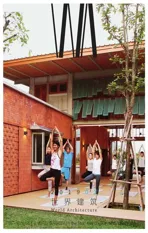绿洲露台,榜鹅,新加坡
2019-04-19建筑设计克里斯托弗系列多样建筑事务所
建筑设计:克里斯托弗·李/系列 + 多样建筑事务所
Architect: Christopher Lee/Serie + Multiply Architects
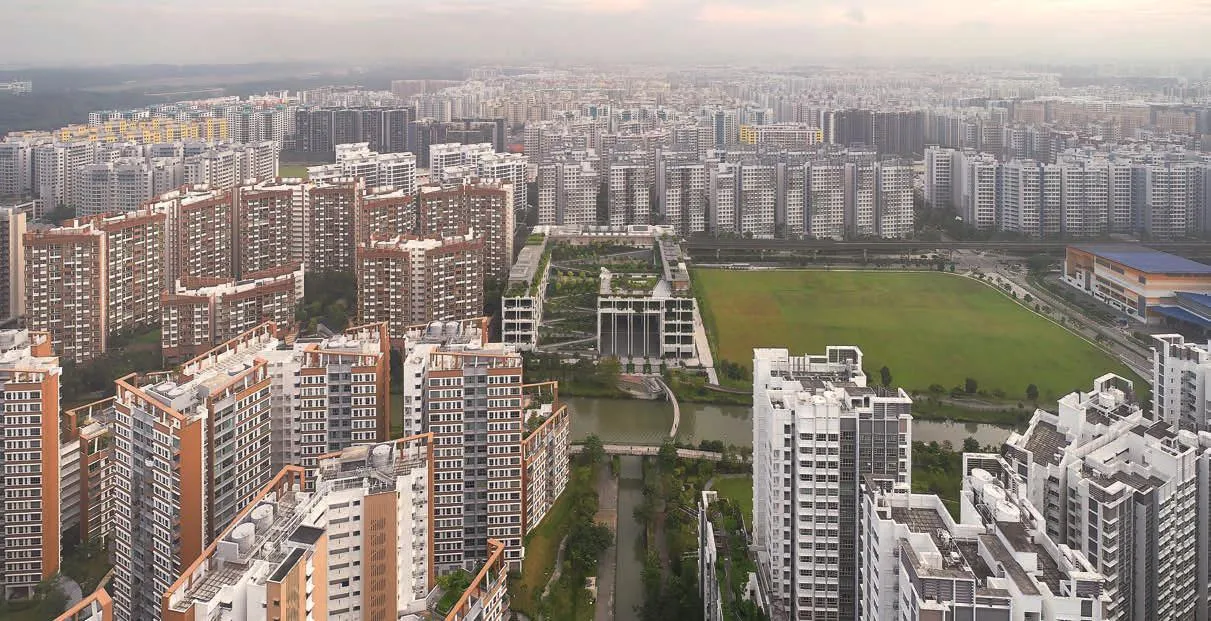
1 鸟瞰/Aerial view
作为新加坡房屋发展局(HDB)委托建造的首批新一代社区中心之一,绿洲露台服务于居住在榜鹅的公共住宅居民,在一栋建筑内汇聚了购物中心、综合诊所和社区设施的功能。对于我们而言,该项目的首要挑战在于如何通过一座建筑将这些各不相同的功能整合为一个清晰的整体,给人们带来既熟悉又新奇的体验。
1970年代和1980年代早期的HDB的住宅小区建筑颇具启发性:公共走廊的开放框架通向独立的公寓,形成一种给人留下深刻印象的、文明的住宅小区和房地产模式。首层的架空平台由鳍状墙连接和划分,类似于公共门廊和柱廊,能够承载各种公共活动——婚礼、葬礼、麻将游戏,甚至是五人制足球赛。它们强烈地呼应着阿尔多·罗西在米兰设计的加拉泰住宅。
我们将这种开放框架的文法转化为建筑的架构,一个社会生活的容器。这一点通过环绕着整个由双柱构成框架的建筑立面的开敞的游廊进行表达。这些空间为面向海滨的餐饮功能提供了关键的溢出区域,同时也为综合诊所提供了休憩空间。同样的双柱还构成了高16m、有顶盖的社交广场,这一区域被特意安排在两条水路的交汇处。这个广场容纳和展示社区活动,公正地表现和履行其职能。
第三个元素,景观,在这个社区中心中被用来激发加强公共纽带的活动。面向水域的一侧,一系列的梯台花园从屋顶层叠而下,延伸至滨水区域,面向场地的标志性要素形成一个景观的圆形剧场。各处都可通达的露台还为项目另一侧的购物中心和综合诊所提供了开放空间、花园、游憩和锻炼的场所。因为露台与建筑框架紧密交织在一起,它们也使得建筑张开的“两条手臂”被“缝合”起来。从露台顶部看去,水路就像是被建筑的两臂以及16m宽的社交广场框在其中。
重中之重在于,绿洲露台展现了激活、转化旧有建筑文法的可能性。对过去受到功能和年代限制的建筑进行抽象和再利用,使其适应我们的当代生活,即能创造出一种全新却令所有人不可思议地感到熟悉的建筑。一座令人熟悉的建筑,作为一种设计模式,往往能够钝化和调节当今社会快速的变化和城市化。它还实现了不同时期的建筑之间的对话,并将建筑创作变为一种属于更广阔的工作和知识体系的艺术实践。换言之,它重申了类型学工作的重要性。□
(克里斯托弗·李 文,庞凌波 译)
As one of the first new generation Neighbourhood Centres commissioned by Singapore's Housing and Development Board (HDB), Oasis Terraces serves the public housing residents of Punggol bringing together a shopping centre, polyclinic and community amenities in a single building.The primary architectural challenge for us here is to cohere these diverse programmes into a legible whole, with an architecture that is both familiar and surprising.
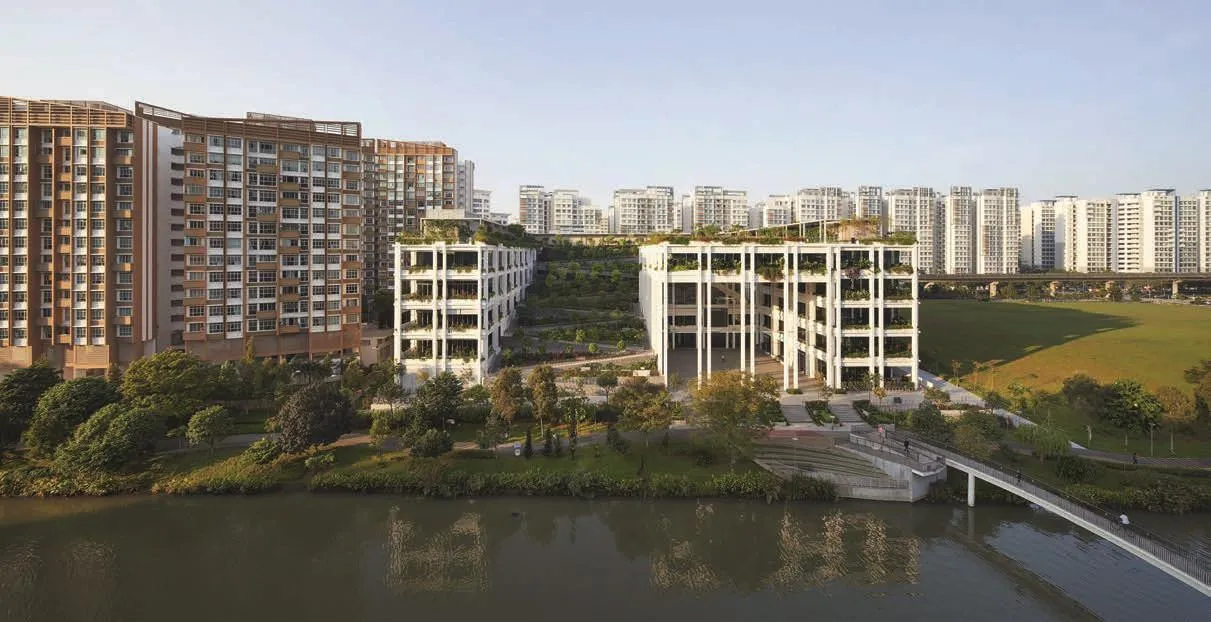
2 近景/Nearby view
The architecture of HDB's housing blocks in the 1970s and early 1980s was instructive: the open frames of the common corridors leading to individual apartments formed an impressive and civilising framework for the housing blocks and the wider estates. Secondly the void decks on the ground floor, articulated and delineated by fin walls resemble communal porticos and colonnades,capable of hosting a diverse range of communal functions - weddings, funerals, mah-jong games and even futsal. They strongly echo Aldo Rossi's 1972 Gallaratese Housing in Milan.
We transposed this grammar of the open frames as an architectural framework, a container of social life. This is expressed as open verandas that surround the entire elevation of the building, framed by double columns. These spaces provide the crucial spill-out areas for dining functions facing the waterfront and as breakout spaces for the polyclinic. The same double columns also frame a 16m tall covered social plaza, deliberately placed to front the junction of the two waterways. This plaza both contains and displays community events, representing and performing its function in equal measure.
The third element, landscape, is used to generate activities that cultivate communal bonds in the neighbourhood centre. Fronting the waterways, a series of terraced gardens cascade down from the roof to the waterfront, forming a landscaped amphitheatre that faces the defining feature of the site. The universally accessible terraces also provide open spaces, gardens, play and exercise areas for both the shopping and polyclinic sides of the project. As the terraces wind up the building they also stitch together its two open arms. From the top of the terraces, the waterway is framed by the arms of the building as well as the 16m wide social plaza.
On a meta-critical level, Oasis Terraces demonstrates the possibility of revalidating and transposing the grammar of persistent architecture.Abstracting and repurposing architecture that has been sanctioned by use and time, into our own contemporary period, serves to create an architecture that is new and yet strangely familiar to all. A familiar architecture, as a common framework tends to blunt and regulate the rapid rate of change and urbanization today. It also sets up a dialogue between the works of architecture of different periods, and takes the creation of architecture as an artistic practice that belongs to a wider body of work and knowledge. In other words, it reasserts the primacy of working typologically.□
(Text byChristopher Lee)
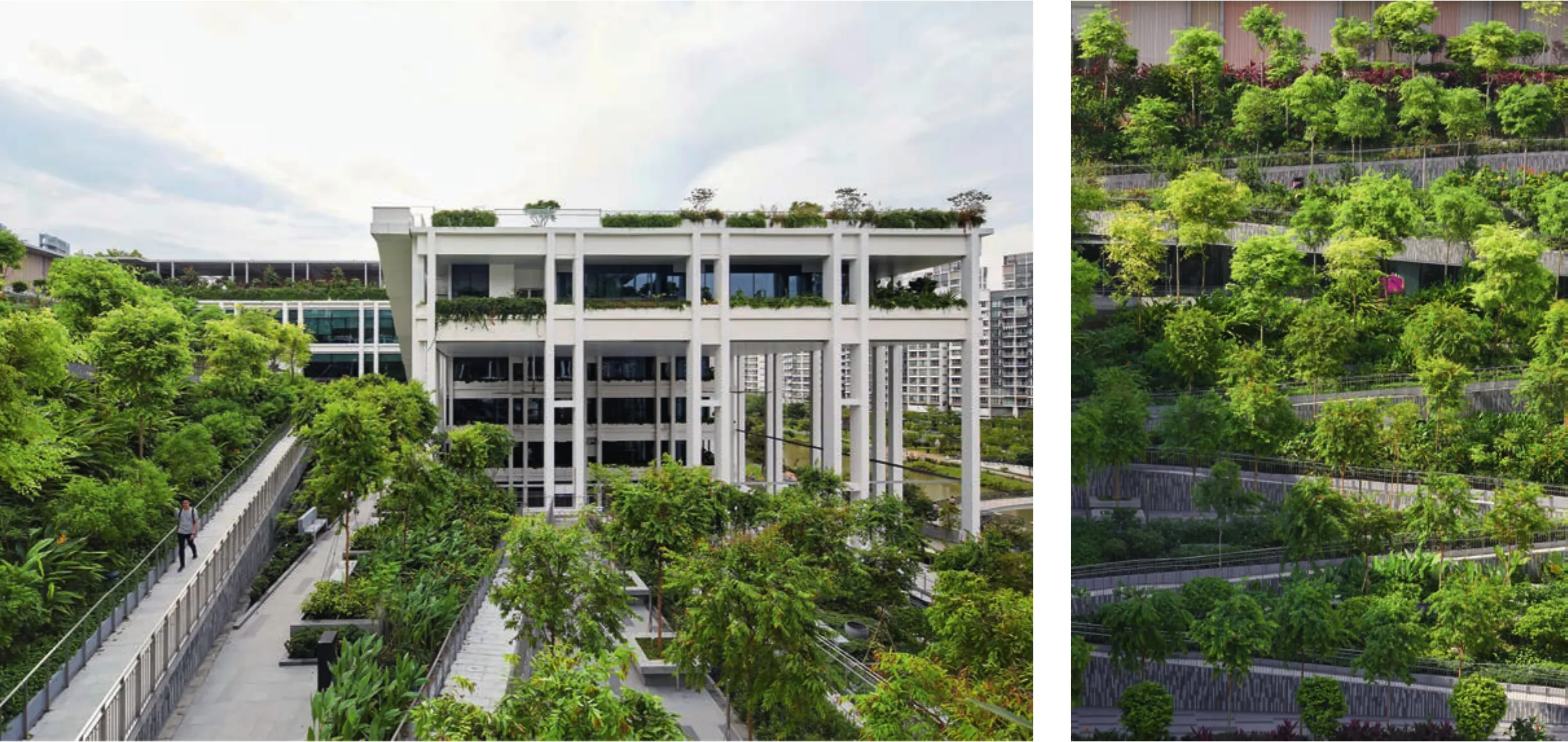
3.4 屋顶露台花园/Roof terrace garden

5 剖面/Section
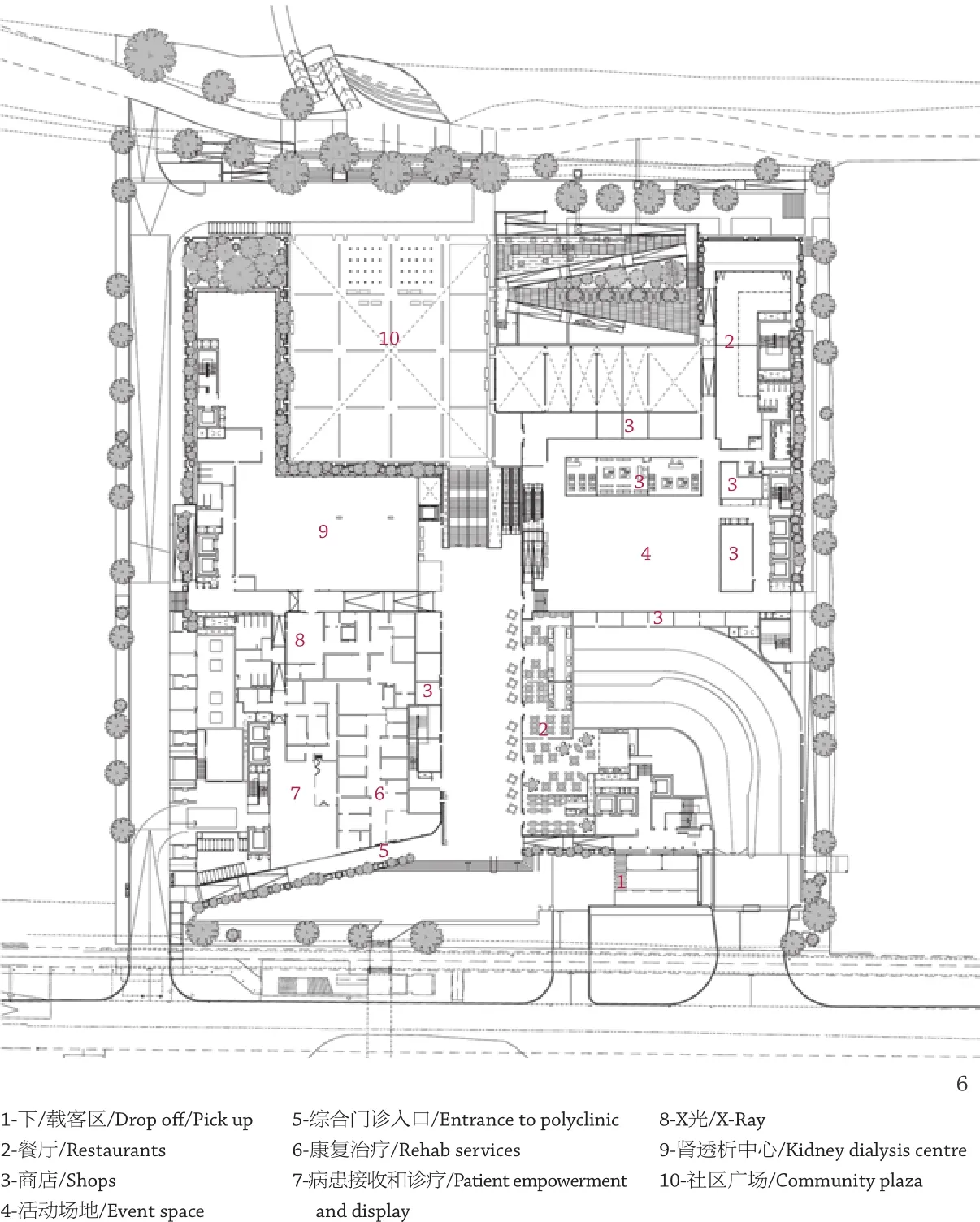
6 首层平面/Ground floor plan
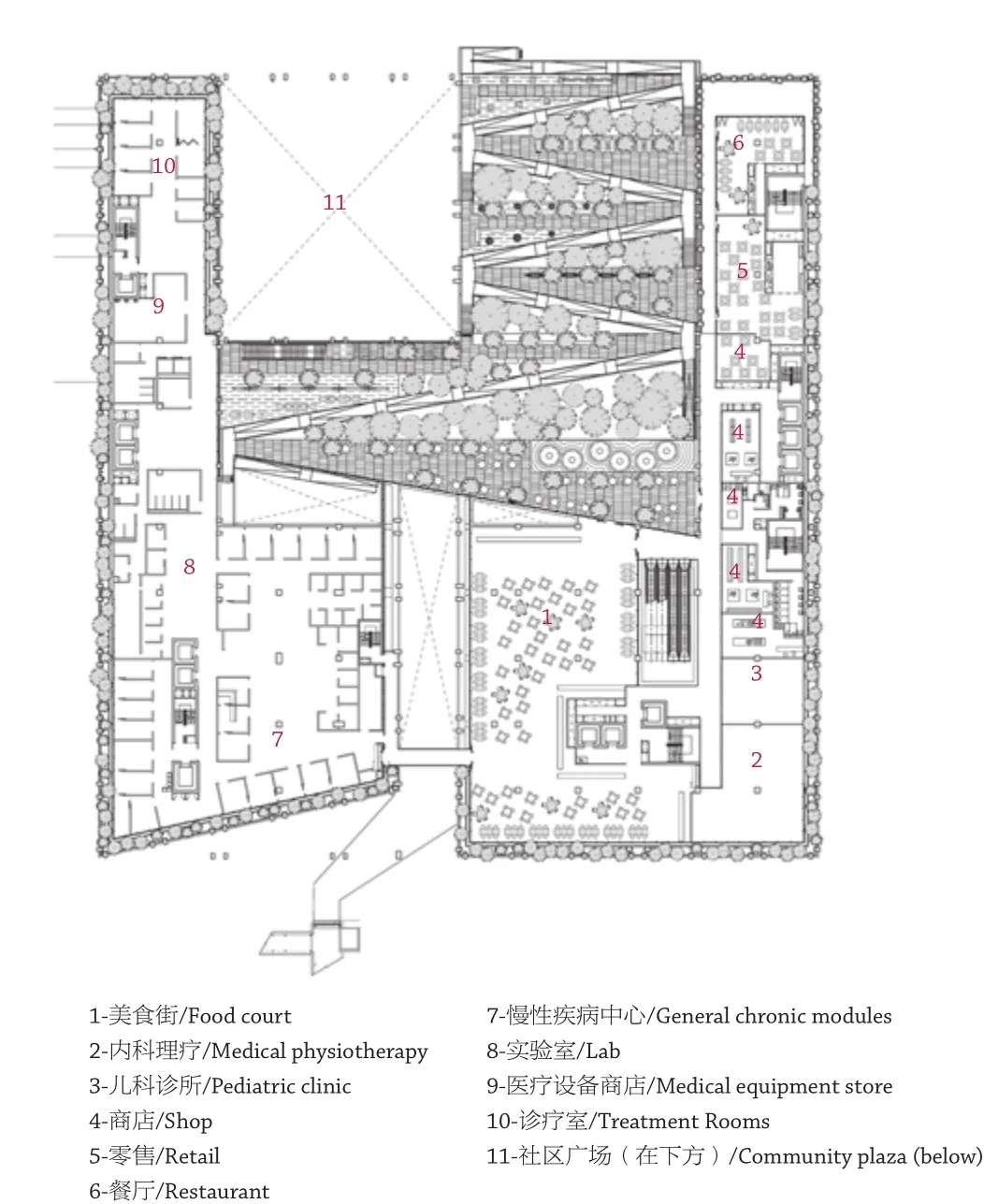
7 二层平面/First floor plan
项目信息/Credits and Data
客户/Client: Singapore Housing & Development Board
建筑设计/Design Architect: Serie Architects
建设执行/Executive Architect: Multiply Architects LLP.
土木工程/Civil & Structural Engineer: KTP Consultants Pte. Ltd.机电工程/Mechanical & Electrical Engineer: Bescon Consulting Engineers Pte.
工料测量/Quantity Surveying: Northcroft Lim Consultants Pte. Ltd.
防火工程/Fire Engineering: C2D Solutions Pte. Ltd.
立面/Façade: Aurecon Singapore Pte. Ltd.
景观/Landscape: WNE Integrated Design Pte. Ltd.
水体净化/ABC: Netatech Pte. Ltd.
绿建/GreenMark: Afogreen Build Pte. Ltd.
声学和视听/Acoustic & Audio Visual: Alpha Acoustics Engineering Pte. Ltd.
灯光/Lighting: Light Cibles Pte. Ltd.
室内设计/Interior Design: Multiply Interiors Pte. Ltd.
医疗计划/Medical Planning: DP Healthcare Pte. Ltd.
工程管理/Project Management: SIPM Consultants Pte. Ltd.
主要承建/Main Contractor: Rich Construction Company Pte. Ltd.
设备承包/Instrumentation Contractor: Geo Application Engineers
摄影/Photos: Hufton + Crow

8.9 外景/Exterior views
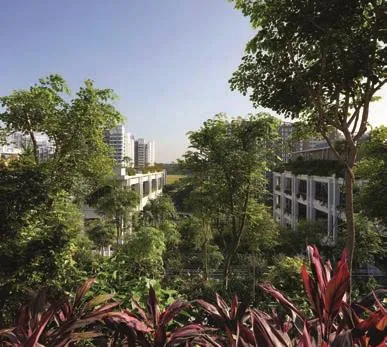
10 俯瞰/Overlook view
评论
杨旭:项目位于新加坡榜鹅,这是在私人发展商承建邻里中心的10余年之后,再次由建屋局建设的新一代邻里中心。其目的在于营造便利、友善的社区空间,而非追求商业利益最大化。项目毗邻榜鹅水道,“向水而生”,居民穿过有遮盖的社区广场,沿着蜿蜒的绿坡与花台可达屋顶。简单纯粹的设计手法,使得建筑极为开放与通透,阳光、空气与视线可自由地穿越整个建筑。而项目中大量的垂直绿化与屋顶绿化,则得益于市区重建局的“打造翠绿都市和空中绿意”(LUSH)计划,体现出公共政策对城市深刻的影响。维罗妮卡·吴:用建筑师克里斯托弗·李的话说,绿洲露台是“公共生活的建筑构架”。该项目的设计是一种创新,它重新定义了新一代新加坡社区中心类型,融合了社区、空间和花园。设计的确是一个场所营建的过程。通过一系列专题小组的讨论,社区的声音被转化为白色框架的集合,这些框架看上去正像是等待填充的空间。
作为第一个新一代社区中心,建筑师提炼了HDB住宅的开放框架,以一种熟悉的形式点缀着新加坡城市与郊区的景观,并用多样混合的使用功能巧妙地填充框架。白色的框架是网格状,融合了不同的功能设置,绿植则软化了原本刚硬的结构边缘。
该项目以空间类型学的简练与清晰清楚地暗示出建筑师希望实现社区与景观之间紧密结合的核心愿景,这种结合表现为城市和公园形式的综合。它的中心像一座风景如画的小山,多层级的花园如瀑布般向榜鹅水道倾斜。坡道串联起这些花园和露台,为建筑提供绿色与宽敞的交通流线通向屋顶。坡道的微观图易使人想起埃米里奥·安柏兹创作的福冈安可乐斯的叠层花园。建筑-园林类型学的对话似乎在新加坡的城市景观中逾加突出,构建起人-空间-场所之间的再发现。
(庞凌波 译)

11 鸟瞰屋顶/Aerial view of the roof

12 屋顶局部/Part of the roof
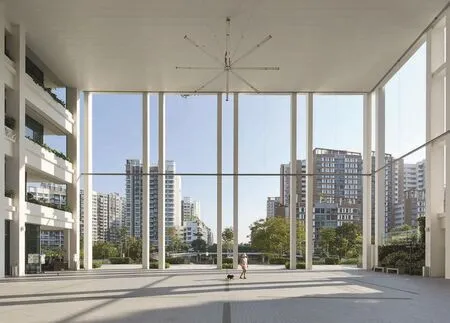
13 广场/Plaza
Comments
YANG Xu: The project is located in Punggol, Singapore.It is a new generation of neighbourhood centre constructed by the Housing Development Board after private real estate developers construct neighbourhood centres for over 10 years. The primary purpose is to create convenient and friendly community space,instead of pursuing for maximum commercial profits.The project is near to the water path of Punggol, and through a sheltered community square, residents can walk to the roof along the winning green slope and flower platform. The application of the simple and pure design method realises an extremely open and transparent construction, and no mater sunshine, air, or people's sight can freely go through the whole building.In addition, the great amount of vertical greening and roof greening in the project adds benefit to the"Landscaping for Urban Spaces and High-Rises (LUSH)"scheme made by the Urban Redevelopment Authority,which showcases the deep influence of public policies upon the city. (Translated by QIAN Fang)Veronica Ng: In the words of Christopher Lee the architect, the Oasis Terrace is an "architectural framework for communal life to unfold in". The design for Oasis Terrace is an innovation that re-defines typology of new generation Singapore's neighbourhood centre fusing community, space and the garden. The design is indeed a place-making process. The voice of the community through a series of focus group discussions is translated into a conglomeration of white frames, which appears as spaces waiting to be fi lled.
Being the first new-gen neighbourhood centre,the architect distills the open frames of the HDB Block typology, a familiar form adorning the Singapore urban and suburban landscape, and neatly in fi lls the frames with diverse mix-used functions. While the white frames are grid-like to fuse together diverse programs,the greens softens the edges of the otherwise rigid structure.
The simplicity and clarity of its spatial typology alludes clearly to the key vision of the architect to achieve a close integration between community and landscape - a synthesis of urban and park forms. Its centre resembles a landscaped hill with multi-tiered gardens cascading towards the Punggol Waterway.Ramps connect these gardens and terraces providing green and generous circulation routes up the building. The microscopic image of the ramps reminisce the cascading gardens of Acros Fukuoka,by Emilio Ambasz. The dialogue of architect-garden typology seemed to gain increasing prominence within the urban landscape of Singapore framing the re-discovery of relationship between people-spaceplace.
